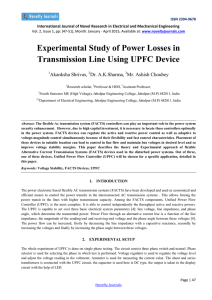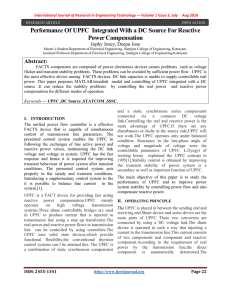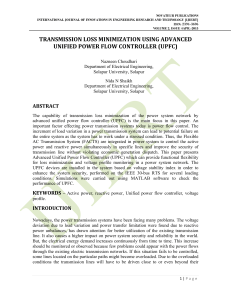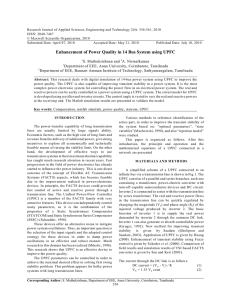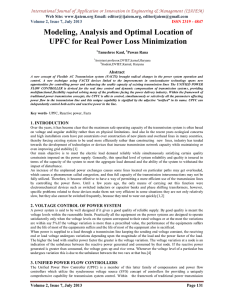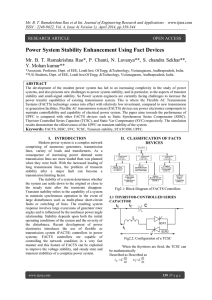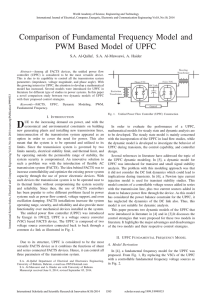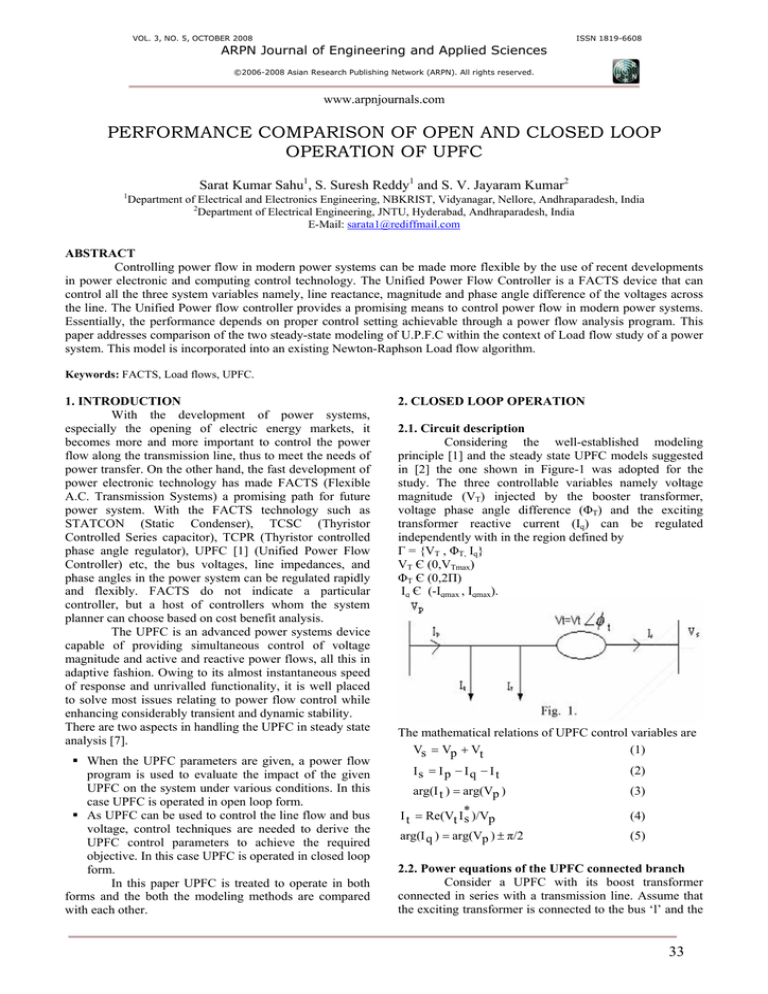
VOL. 3, NO. 5, OCTOBER 2008
ISSN 1819-6608
ARPN Journal of Engineering and Applied Sciences
©2006-2008 Asian Research Publishing Network (ARPN). All rights reserved.
www.arpnjournals.com
PERFORMANCE COMPARISON OF OPEN AND CLOSED LOOP
OPERATION OF UPFC
1
Sarat Kumar Sahu1, S. Suresh Reddy1 and S. V. Jayaram Kumar2
Department of Electrical and Electronics Engineering, NBKRIST, Vidyanagar, Nellore, Andhraparadesh, India
2
Department of Electrical Engineering, JNTU, Hyderabad, Andhraparadesh, India
E-Mail: sarata1@rediffmail.com
ABSTRACT
Controlling power flow in modern power systems can be made more flexible by the use of recent developments
in power electronic and computing control technology. The Unified Power Flow Controller is a FACTS device that can
control all the three system variables namely, line reactance, magnitude and phase angle difference of the voltages across
the line. The Unified Power flow controller provides a promising means to control power flow in modern power systems.
Essentially, the performance depends on proper control setting achievable through a power flow analysis program. This
paper addresses comparison of the two steady-state modeling of U.P.F.C within the context of Load flow study of a power
system. This model is incorporated into an existing Newton-Raphson Load flow algorithm.
Keywords: FACTS, Load flows, UPFC.
1. INTRODUCTION
With the development of power systems,
especially the opening of electric energy markets, it
becomes more and more important to control the power
flow along the transmission line, thus to meet the needs of
power transfer. On the other hand, the fast development of
power electronic technology has made FACTS (Flexible
A.C. Transmission Systems) a promising path for future
power system. With the FACTS technology such as
STATCON (Static Condenser), TCSC (Thyristor
Controlled Series capacitor), TCPR (Thyristor controlled
phase angle regulator), UPFC [1] (Unified Power Flow
Controller) etc, the bus voltages, line impedances, and
phase angles in the power system can be regulated rapidly
and flexibly. FACTS do not indicate a particular
controller, but a host of controllers whom the system
planner can choose based on cost benefit analysis.
The UPFC is an advanced power systems device
capable of providing simultaneous control of voltage
magnitude and active and reactive power flows, all this in
adaptive fashion. Owing to its almost instantaneous speed
of response and unrivalled functionality, it is well placed
to solve most issues relating to power flow control while
enhancing considerably transient and dynamic stability.
There are two aspects in handling the UPFC in steady state
analysis [7].
When the UPFC parameters are given, a power flow
program is used to evaluate the impact of the given
UPFC on the system under various conditions. In this
case UPFC is operated in open loop form.
As UPFC can be used to control the line flow and bus
voltage, control techniques are needed to derive the
UPFC control parameters to achieve the required
objective. In this case UPFC is operated in closed loop
form.
In this paper UPFC is treated to operate in both
forms and the both the modeling methods are compared
with each other.
2. CLOSED LOOP OPERATION
2.1. Circuit description
Considering the well-established modeling
principle [1] and the steady state UPFC models suggested
in [2] the one shown in Figure-1 was adopted for the
study. The three controllable variables namely voltage
magnitude (VT) injected by the booster transformer,
voltage phase angle difference (ΦT) and the exciting
transformer reactive current (Iq) can be regulated
independently with in the region defined by
Γ = {VT , ΦT, Iq}
VT Є (0,VTmax)
ΦT Є (0,2П)
Iq Є (-Iqmax , Iqmax).
The mathematical relations of UPFC control variables are
Vs = Vp + Vt
(1)
Ιs = Ι p − Ιq − Ι t
(2)
arg(Ι t ) = arg(Vp )
(3)
Ι t = Re(Vt Ι*s )/Vp
(4)
arg(Ι q ) = arg(Vp ) ± π/2
(5)
2.2. Power equations of the UPFC connected branch
Consider a UPFC with its boost transformer
connected in series with a transmission line. Assume that
the exciting transformer is connected to the bus ‘l’ and the
33
VOL. 3, NO. 5, OCTOBER 2008
ISSN 1819-6608
ARPN Journal of Engineering and Applied Sciences
©2006-2008 Asian Research Publishing Network (ARPN). All rights reserved.
www.arpnjournals.com
two terminals of the transmission line are denoted as
bus‘s’ and ‘m’ respectively. By using the UPFC model [3]
illustrated in Figure-1 and ‘pi’ equivalent circuit of the
transmission line, the branch with the UPFC connected
between bus ‘l’ and ‘m’ can be modeled as shown in
Figure-2. Zlm = Rlm + jXlm and jBlm denote the parameters
of the transmission line. Yl and Ym represent the system
shunt admittance at bus ‘l’ and ‘m’, respectively.
After modifying all of the UPFC embedded branches the
load flow equations can be written as follows:
Q Gi − Q Li = ∑ Vi V j ⎛⎜ G ij cosδ ij − B ijsinδ ij ⎞⎟
(18)
⎝
⎠
PGi − PLi = ∑ Vi V j ⎛⎜ G ij cosδ ij + B ij sinδ ij ⎞⎟
⎝
⎠
(
)
i=1,2,3…………………n; but i≠l,m
PGl − PLl = ∑ Vl V j G ljcosδ lj + B ljsinδ lj + Plm
S ml = Pc + jQ c = Pf + jQ f + ∆S e
(6)
*
⎛ V m − Vl
⎞
⎜
⎟
+ jB lm Vm Vm
Pf + jQ f =
⎜R
⎟
⎝ lm + jX lm
⎠
*
⎛
⎞
Vt
⎟ Vm
∆S e = Pe + jQ e = −⎜
⎜R
⎟
⎝ lm + jX lm ⎠
S lm = Plm + jQ lm
(7)
(8)
(9)
⎛ P2 + Q2
⎞
c + B 2 V 2 + 2B Q ⎟ − p (10)
Plm = R lm ⎜ c
c
lm m
lm c ⎟
⎜
2
⎝ Vm
⎠
⎡ E V −1 + F V sinδ
⎤
lm ⎥ V
Q lm = − I q Vl − ⎢ 1 m −1 1 m
(11)
⎢⎣ − E 2 Vm + F2 Vm cosδ lm ⎥⎦ l
(
(
)
)
E1 = C x Pc + C y Q c
12)
E 2 = C y Pc − C x Q c
F1 = B lm C y
(13)
F2 = − B lm 1 + C x
C x = 1 − B lm X lm
C y = B lm R lm
(15)
(
)
(14)
(16)
(17)
δ lm = δ l − δ m , δlm is the phase angle difference
between bus ‘l’ and ‘m’
2.3. Load flow equations
Assume that for a given control strategy the
power Sml on the UPFC controlled transmission line l-m is
set to constant Pc + jQc. By means of substitution theorem,
this branch l-m can be detached as shown in Figure-3 in
which Sml represents power from bus ‘m’ and Slm
represents power from bus’l’. For each other additional
UPFC, its corresponding branch can be dealt with
similarly.
Q
Gm
−Q
Lm
(19)
(20)
⎞
⎛
= ∑ Vm V ⎜ G cosδ − B sinδ ⎟ + Q c
j ⎝ mj
mj
mj
mj ⎠
(21)
PGm − PLm = ∑ Vm V j ⎛⎜ G mj cosδ mj + B mjsinδ mj ⎞⎟ + Pc
⎝
⎠
(22)
Q Gl − Q Ll = ∑ Vl V j G ljcosδ lj − B ljsinδ lj + Q lm (23)
(
)
2.4. Load flow computation
Since Sml = Pc+jQc is set as constant for the given
control requirement, Slm = Plm+jQlm can be treated as a
special load varying with respect to the voltages Vl and
Vm. As a result, the UPFC’s have already been decoupled
from the system and the load flow equations (18-23) can
be solved by standard Newton Raphson load flow
program.
2.5. Computation for the UPFC control setting
After the load flow computation converges, the
control setting of the UPFC can be computed as follows.
First Pf and Qf are computed from (7). Note that Pc and Qc
are given and (6) gives
(24)
∆S e = Pe + jQ e = Pc + jQ c − Pf − jQ f
V t ∠ φ t = − (Pe − jQ e )(R lm + jX lm )/(V m ∠ δ m ) (25)
[(
)(
)]
2
2
2
2 1/2
Vt = Pc + Q c R lm + X lm
/Vm
φt = γ −β + δm
(26)
(27)
⎡X
⎤
γ = arctg[Q e /( − Pe )] , β = arctg ⎢ lm
(28)
R ⎥⎥
⎢⎣
lm ⎦
From (25) and (26) VT and ΦT can be determined readily
once the load flow calculation converges for the given (Pc,
Qc).
34
VOL. 3, NO. 5, OCTOBER 2008
ISSN 1819-6608
ARPN Journal of Engineering and Applied Sciences
©2006-2008 Asian Research Publishing Network (ARPN). All rights reserved.
www.arpnjournals.com
2
Q k = − Vk B kk + Vk Vm (G km sin(θ k − θ m )
3. OPEN LOOP OPERATION
3.1. Circuit description
The steady state model is based [4] on two ideal
voltage source converters. One in series with the line and
one are in shunt with the line. The output voltage of the
series converter is added to the AC terminal voltage Vo via
the series connected coupling transformer. The injected
voltage Vcr acts as an AC series system voltage source
changing the effective sending end voltage as seen from
node m. The product of transmission line current Im and
series voltage source Vcr, determines the active and
reactive power exchanged between the series converter
and AC system. The real power demanded by the series
converter is supplied form the AC power system by the
shunt converter via the common DC link.
− B km cos(θ k − θ m ))
+ Vk Vcr (G km sin(θ k − θ cr )
− B km cos(θ k − θ cr ))
+ Vk Vvr (G vr sin(θ k − θ vr )
− B vr cos(θ k − θ vr ))
At node 'm',
2
Pm = Vm G mm + Vm Vk (G mk cos(θ m − θ k )
+ B mk sin(θ m − θ k ))
+ Vm Vcr (G mm cos(θ m − θ cr )
3.2. Equivalent circuit and power equations
The UPFC equivalent circuit shown in Figure-4 is
used to derive steady state model. The equivalent circuit
consists of two ideal voltage sources representing the
fundamental Fourier series component of the switched
voltage waveforms at the AC converter terminals. The
ideal voltage sources are:
+ B mmsin(θ m − θ cr ))
2
Q m = − Vm B mm + Vm Vk (G mk sin(θ m − θ k )
Vvr = Vvr (cos θvr + j sin θvr)
Vcr = Vcr (cos θcr + j sin θcr)
At series converter,
2
Pcr = Vcr G mm + Vcr Vk (G km cos(θ cr − θ k )
+ B km sin(θ cr − θ k ))
(29)
(30)
(32)
(33)
− B mk cos(θ m − θ k ))
+ Vm Vcr (G mmsin(θ m − θ cr )
− B mm cos(θ m − θ cr ))
(34)
+ Vcr Vm (G mm cos(θ cr − θ m )
+ B mmsin(θ cr − θ m )
(35)
2
Q cr = − Vcr B mm + Vcr Vk (G km sin(θ cr − θ k )
− B km cos(θ cr − θ k ))
+ Vcr Vm (G mm sin(θ cr − θ m )
− B mm cos(θ cr − θ m ))
The real and reactive powers injected at the nodes k, m
and also at series converter and shunt converter.
At node k,
2
Pk = Vk G kk + Vk Vm (G km cos(θ k − θ m )
+ B km sin(θ k − θ m ))
+ Vk Vcr (G km cos(θ k − θ cr )
+ B km sin(θ k − θ cr ))
At shunt converter,
2 G + V V (G cos(θ − θ )
Pvr = − Vvr
vr
vr k vr
vr
k
+ B vr sin(θ vr − θ k ))
(37)
2 B + V V (G sin(θ − θ )
Q vr = Vvr
vr
vr k vr
vr
k
− B vr cos(θ vr − θ k )
(38)
Where
+ Vk Vvr (G vr cos(θ k − θ vr )
+ B vr sin(θ k − θ vr ))
(36)
(31)
−1 + Z −1
Ykk = G kk + jB kk = Z cr
vr
(39)
−1
Ymm = G mm + jB mm = Z cr
(40)
35
VOL. 3, NO. 5, OCTOBER 2008
ISSN 1819-6608
ARPN Journal of Engineering and Applied Sciences
©2006-2008 Asian Research Publishing Network (ARPN). All rights reserved.
www.arpnjournals.com
−1
Ykm = G km + jB km = − Z cr
(41)
−1
Yvr = G vr + jB vr = − Z vr
(42)
Assuming a free loss converter operation, the UPFC
neither absorbs nor injects active power with respect to the
A.C system. The dc line voltage Vdc, remains constant.
The active power associated with series converter becomes
the DC power Vdc *I2. The shunt converter must supply an
equivalent amount of DC power to maintain Vdc constant.
Hence the active power supplied to the shunt converter Pvr,
must satisfy the active power demanded by series
converter, Pcr i.e.,
Pcr + Pvr = 0
(43)
The UPFC linearised power equations are combined with
the linearised system of equations corresponding to the
rest of network as
[f(X)] = [J ][X ]
where
[
f (X ) = ∆Pk ∆Pm ∆Q k ∆Q m ∆Pcr ∆Q cr ∆Pbb
(44)
]T
(45)
∆Pbb is the power mismatch and superscript ‘T’ indicates
transposition. ‘X’ is the solution vector and ‘J’ is the
jacobian matrix, where
[X] = [∆θ k ∆θ m ∆Vvr ∆Vm ∆θ cr ∆Vcr ∆θ vr ]T
(46)
This steady state model is suitable for interpolation into an
existing Newton-Raphson load flow algorithm. In
common with all other controllable plant component
models available in algorithm, the UPFC state variables
and interpolation inside the Jacobian matrix and mismatch
equations, leading to a best iterative solution.
4. CASE STUDY
4.1. Open loop control
A five-bus network has been used to show
quantitatively, how the UPFC performs. The power system
model was drawn in simulink and it was simulated using
PSAT/SIMULINK. The original network is modified to
include UPFC as shown in Figure-5, which compensates
the line between buses 3 and 4 The UPFC is used to
regulate the active and reactive power flowing in the line
at a pre specified value.
The load flow solution for the modified network
is obtained by using Newton-Raphson method. Once the
load flow is converged the final values of voltages at 3rd
and 4th node are taken and the UPFC control setting is
determined. The maximum amount of active power
exchanged between the UPFC and the AC system will
depend on the robustness of UPFC shunt bus i.e., bus
‘3’.Since the UPFC generates its own reactive power, the
generator at the 1st bus reduces its reactive power as
observed from the simulation studies It must be noted that
selected UPFC initial conditions have a good impact on
the convergence of load flow problem in open loop
system. If the initial values of UPFC are not chosen in a
proper way, the load flow problem diverges, because the
initial conditions are estimated by using the pre specified
power flows.
4.2. Closed loop control
The original network is modified to include
UPFC which compensates the line between buses 3 and 4 .
The UPFC is used to regulate the active and reactive
powers leaving UPFC towards node ‘4’ at specified
values. Moreover the UPFC shunt converter is set to
regulate the node voltage at bus 3 at 1 p.u. (Or any other
specified value).The converged load flow results can be
used to determine the control settings of UPFC. In closed
loop control, the control setting of UPFC can be
determined directly without iteration and hence have no
need for any assumption of initial values. Keeping the load
demand at the buses where UPFC is connected, the pre
specified real and reactive power flows are gradually
increased to see how the control setting of UPFC is
changed. As the pre specified real power is increased, the
UPFC series voltage is increasing in quadrature with the
system voltage. The results of both the close loop and
open loop systems are given in Tables 1 and 2,
respectively. The final converged values of UPFC series
and shunt voltage sources are also mentioned in Table-2.
In both the cases to compare the results the pre specified
power flow from bus ‘3’ to bus’4’ is kept same and studies
are carried out. The number of iterations for convergence
in open loop system is more when compared with the
36
VOL. 3, NO. 5, OCTOBER 2008
ISSN 1819-6608
ARPN Journal of Engineering and Applied Sciences
©2006-2008 Asian Research Publishing Network (ARPN). All rights reserved.
www.arpnjournals.com
closed loop system. It is because of the factor that the
number of non linear equations in open loop system is
more when compared with closed loop system.
Table-1. Closed loop control.
Load demand
(MW)
Pre-specified
line flow
(p.u)
UPFC
voltage
Angle
(Φt)
Bus
‘3’
45
Bus
‘4’
40
Pc
Qc
(Vt) pu
radians
0.2
0.01
0.0072
-1.9828
45
40
0.24
0.01
0.0091
-1.8323
45
40
0.34
0.02
0.1474
-1.683
45
40
0.40
0.03
0.0181
-1.650
45
40
-0.34
0.02
0.0259
-1.150
Table-2. Open loop control.
Load demand
(MW)
Bus’3’ Bus’4’
UPFC parameters
Vcr
θ cr
Vvr
θ vr
45
40
0.0648
-1.5917
1.0493
-0.0950
45
40
0.0590
-0.8272
0.9783
-0.0853
45
40
0.0488
-0.5791
0.9191
-0.0703
45
40
0.0403
-0.4594
0.8611
-0.0583
45
40
0.0646
-1.8515
1.0566
-0.1171
flow calculation. IEE Proceedings on generation
transmission distribution. 146(4): 365-369.
[4] C.R. Fuerte Esquivel, Acha E. 1997. Unified power
flow controller: a critical comparison of NewtonRaphson UPFC algorithms in power flow studies. IEE
Proceedings on generation, transmission distribution.
144(5): 437- 444.
[5] C.R Fuerte Esquivel, Acha E. 1996. Newton-Raphson
algorithms for the reliable solution of large power
networks with embedded FACTS devices. IEE
Proceedings on generation, transmission, distribution.
143(5): 447-454.
[6] C.R. Fuerte Esquivel, Acha E. 1998. Efficient object
oriented power systems software for the analysis of
large scale networks containing FACTS controlled
branches. IEEE transactions on power systems. Vol.
13, No. 2, May.
[7] Yong Hua Song and Allan T. Johns. Flexible AC
transmission systems.
[8] W. Stagg and A.H. El-abiad. Computer method in
power system analysis.
5. CONCLUSIONS
In this paper a steady state model based on power
flow between two buses is presented. It is observed that in
closed loop operation as the pre specified real power flow
is increased the voltage angle (ФT) is reaching near –90o.
In open loop operation prior to the incorporation of UPFC
the power transfer between bus ‘3’ and ‘4’ is 18-j5.2.After
the UPFC is incorporated the power flow has been
changed to 34-j5. This is done by appropriately choosing
the initial conditions of the UPFC. The disadvantage in
open loop operation is that we have to choose appropriate
initial conditions other wise we may not get the solution
for the load flow.
REFERENCES
[1] Gyugui L. 1992. Unified power flow control concept
for flexible AC transmission system. IEE ProceedingsC. 139(4): 323-333.
[2] Nabavi-Naiki A., Iravani M.R. 1996. Steady state and
dynamic models of Unified power flow controller for
power system studies. IEEE Transactions power
systems. 11(4): 1937-1943.
[3] W.L. Fang, H.W. Ngan. 1999. Control setting of
Unified power flow controllers through a robust load
37

